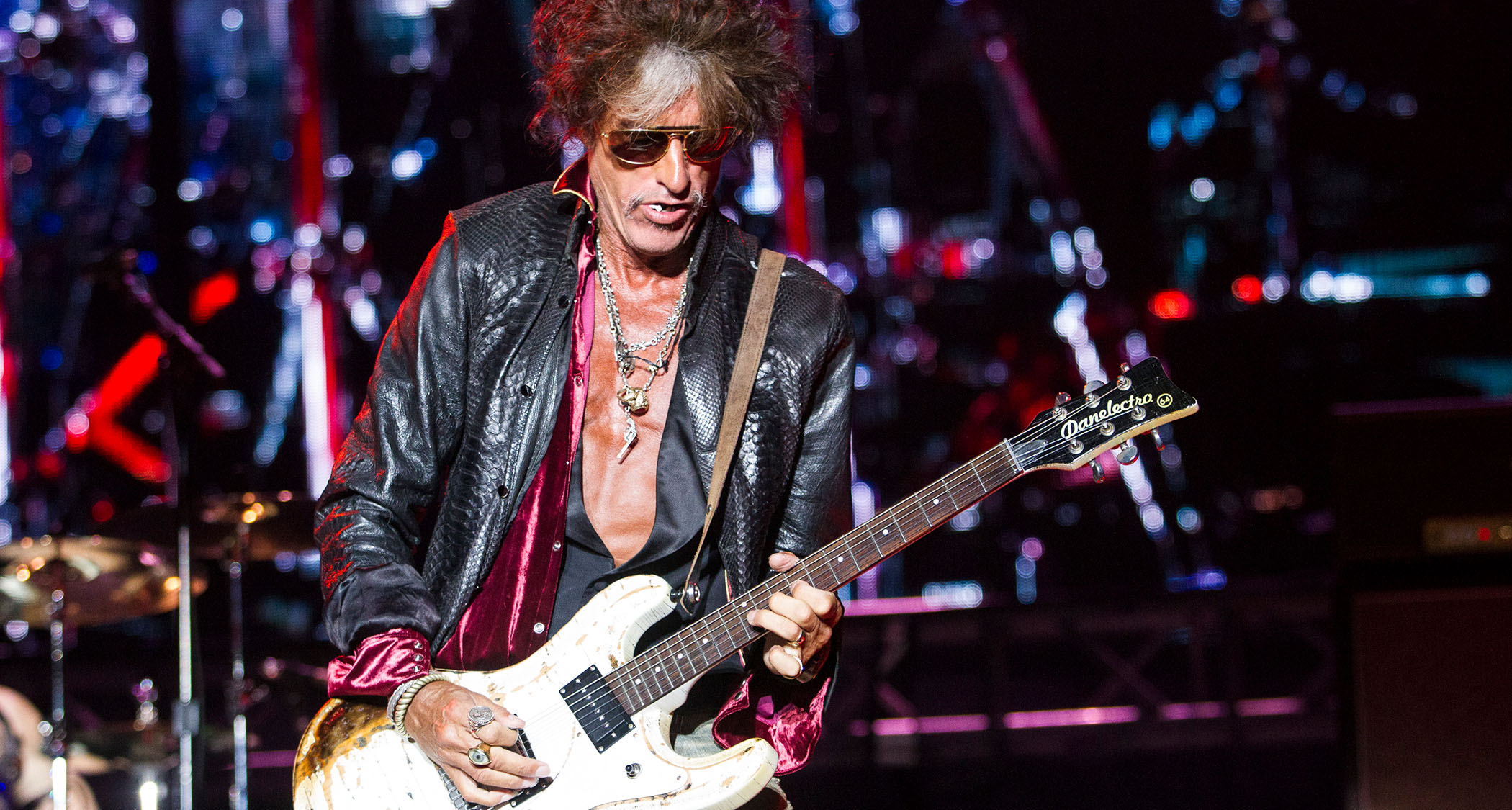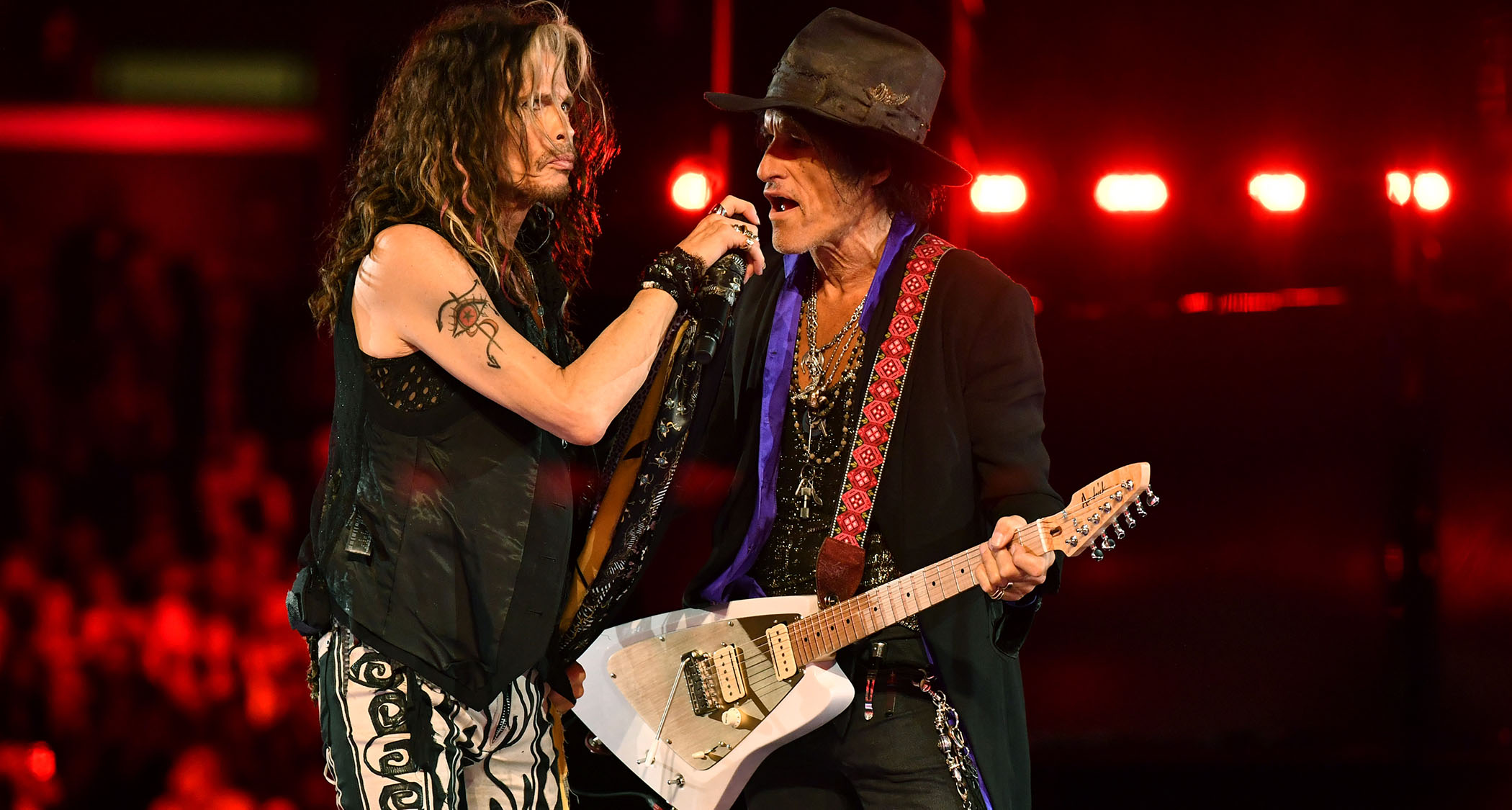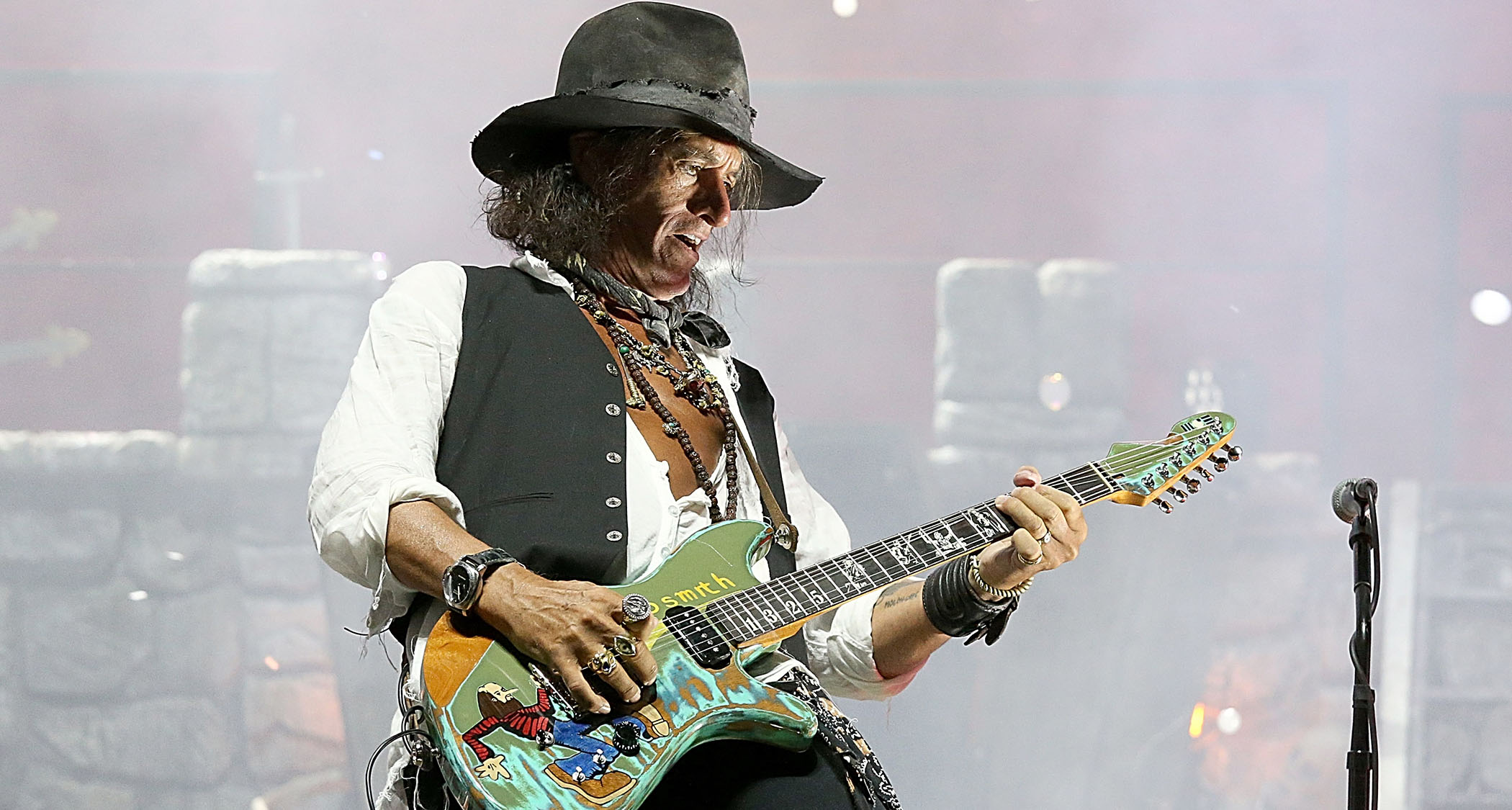
Joe Perry has one of the most epic guitar collections on the planet, and we’re not just talking just primo vintage unicorns, ’59 Gibson Les Paul Standards, ’62 Stratocasters, and all that collector’s gold. He’s got all kinds of weird guitars.
He likes oddball electric guitars, strange shapes with reverse headstocks, finishes that look like they’ve been recovered from the ocean.
There are custom builds and stock Strats, too. And as he reveals in this edition of Bought & Sold – your monthly repository of gear stories from guitar’s best and brightest – Perry even has a serious crush on the post-war European guitars, and he has a particular liking of one very special (and inexpensive) Harmony hollowbody that has got riffs in it and lots of them.
What was the first serious guitar that you bought with your own money?
“I got a Guild Starfire IV. It was the one that didn’t have the master volume knob, but it was good. It had the two smaller humbucker-style pickups and it pretty much had that classic ES-335 shape, you know – the double‑cutaway with the holes. It was Guild’s version of that.
“I always wanted a Gibson, like that vibe, but I didn’t have the money and that one was hanging on the wall. So that’s what I got. That served me pretty well until I really got rolling.”
What was the last guitar you bought and why?
“I haven’t gotten it yet, but I put an order in for the six-string basses that Fender is reissuing. I had an original six‑string bass that I wrote Back In The Saddle with; I played that on stage in the ’70s. It had four toggle switches on it and was stolen in the late ’80s. I was really bummed about that, of course, and I was on the road. I was scrambling for another six-string bass and the only thing I could find was a three-toggle version.
“It was okay, but I talked to the guys at Music Man and they made me a six-string bass, which has a shorter scale length and a little wider neck. They put a Floyd Rose on it because I liked that vibrato for six-string bass chords.
I’ve written some riffs that have ended up being on some of my favourite songs with this old Harmony hollowbody
“When you play that, you get a little bit of that movement with the bar and it sounds amazing. So that’s what I’ve been using live for the last 20 years; it’s a little easier to play and a little easier on my fingers when we do Back In The Saddle. But I saw that Fender is reissuing some of these, and they’re probably as good as they were made back then. So I’ve got an order in for one of those.
“The other guitar I shelled money out for was a Strat that somebody showed me from Fender. It’s kind of a purple that has been distressed and it just looks beautiful. The thing is, they are only sold through Sweetwater and I had to have it, so I bought it from Sweetwater. I used that quite a bit on the recent Hollywood Vampires tour.”
What’s the most incredible find or bargain you’ve ever had when buying guitars?
“I have to say, they all feel like bargains when you get them in your hands, you know? There’s a reason – there’s something about every one of those, whether it’s a late-’50s [Les Paul] Junior with one P-90, a hollowbody Harmony, or whatever. If you pick it up and you can play it… there are no bad tones, no wrong tones. It’s just what it inspires you to do.
When I’m buying guitars some of my favourites are the European guitars from the ’50s and ’60s. That’s some incredible stuff. They’re not what’s on the cover of Guitar World this month, but there’s something about them
“You may pick up a guitar, and there’s something that’s harmonically a little different and it may inspire you to write a riff that you might not have if you picked up your old standard whatever-it-is. So that’s why when I’m buying guitars some of my favourites are the European guitars from the ’50s and ’60s. That’s some incredible stuff. They’re not what’s on the cover of Guitar World this month, but there’s something about them.
“I’ve written some riffs that have ended up being on some of my favourite songs with this old Harmony hollowbody. It has like an old piezo in it; it’s just got this great feel. I’ve written some riffs that I probably wouldn’t have written if I hadn’t picked that guitar up. That’s why my guitar collection is probably half oddballs, Airlines, and those kinds of guitars.”
Have you ever experienced buyer’s remorse after acquiring a guitar?
“Not really. I’m terrible about getting rid of stuff to make room for something else [laughs]. It’s like when you have a workshop and you’ve got scrap metal or wood; you put it away because you never know when that will come in handy. And that increases my vocabulary for when I’m in the studio.
“You don’t know what’s going to work; there aren’t horrible guitar sounds. Obviously, if it’s unplayable, or – well, I can’t even say that because there are some guitars on which you might only get three strings working and that might just be the sound you need for an overdub. You never know. So it’s tough to say that I have any regrets about buying guitars. Though it does lead me to the question that I know is coming…”
Have you ever sold a guitar that you now intensely regret letting go?
“I have to say that I’ve probably had an equal number of guitars stolen from me as what I’ve sold. I had a Junior, which was a single-cutaway with a P-90 and just a flat body. It was my main guitar back in the ’70s, and it got stolen. I miss that one.
“But with selling, I’ve got a story. In the ’90s, when we had a place up on Lake Sunapee [in New Hampshire], on 4 July they would have fireworks out in the harbour. Every year, we would get out on the boat and there were hundreds of boats all parked out in the harbour to watch the fireworks.
“Back then, it was kind of hard to find amplifiers that worked off batteries, but there were a couple of things. I think Fender had these things that looked like a can, had a battery in them and were very loud. I got a transformer hooked up to the battery on the boat, and I got a couple of amps working; it was loud enough and the sound travels pretty well across water.

“It was one of those quiet nights before the fireworks went off. Families were out on the boats, and I had this guitar that I found out on the road somewhere – it was a red Hofner copy of a Strat that sounded a little Strat-y. So I knew the fireworks were going to start at 8pm, so at about 7.30 I turned all the amps on and I played The Star‑Spangled Banner and it echoed across the water.
“Nobody really knew who was playing or where it came from, but it was fun. Families were in the boats and people were clapping. So I did that for a couple of years with that particular guitar, and as the years went on the guitar ended up getting back with my main collection.
“I was kinda in one of those moods at the end of the tour, and I had like 400 of these guitars that I never played. I said, ‘I gotta get rid of some of these things. It’s time to clean house a little bit.’ I earmarked a few guitars to go and somehow that guitar got on the list. And like three or four months later, I found out that it was gone and was like, ‘Next time, I gotta pay more attention to this. I’m not getting rid of anything else for a while.’”

“A couple of years later, we’re on the bullet train in Japan, and as the bullet train is pulling out 30 or 40 people follow us up there. As the train was moving along, I saw a kid holding that guitar out for me to sign it. But the train was already moving, slowly pulling out, and the kid was holding it out with a Magic Marker. I’m thinking, ‘Man, I gotta get the kid’s number to see if I could buy it back or trade it for something else,’ because it did have some sentimental value, you know?
“But we were off to the next city, and at that point I didn’t have any ideas about how to get in touch with the guy. I suppose I could have tracked him down through the fan club and tried to figure out who it was, but it was lost. That’s one guitar I would like to try and buy back because it had sentimental value to me during those times up on the lake.”
Hopefully, someone reading this will find a way to get the guitar back to you.
“I’ll buy it back. I’ll trade it for something else, you know? It would be fun to get that back. And again, that was one of those off-the-wall, not exactly the hippest guitar of the month. But it sounded pretty cool and it had a really good neck. It was more about the sentimental things. I regret having lost that.”
What’s your best guitar-buying tip?
“Spend a little time with it. If it’s in the guitar store, plug it in and close your eyes and if it’s right, you’ll know. You can generally tell if a guitar is going to be a good one by how it sounds when it’s not plugged in. A lot of it is how the wood and the metal react, how it sustains and how it feels; that’s the most important thing.
“It can even be a $120 guitar, but if it feels right to you, that’s what you gotta go by. So much of it has to do with how it feels in your hands and how it hits your ears. I’ve found very often that sometimes you have to try things that don’t go by the book or don’t follow the rules.”
“I remember doing the solo for Janie’s Got A Gun, and I wanted something that sounded really angry and really, really nasty because it was that kind of a song. I plugged in – I had a Gibson Chet Atkins, and they can sound harsh if you turn them up too much because they’re meant to sound like a loud acoustic guitar.
“I had it plugged into a 15-watt Marshall transistor practice amp, and I turned the volume all the way up. I played it for Bruce Fairbairn, the producer, and he said, ‘It sounds like shit,’ and it kind of did [laughs].
“It was pretty crazy and nasty. It had that mid top-end that you can get with a transistor amp, especially those early ones. They have their place in the sound spectrum. But overall, well, it was definitely nasty. But I said, ‘Well, let’s just give it a try.’ It had that bite and it worked for me. For something else, it would be totally wrong, but for that, it worked great.”
When was the last time you stopped and looked in a guitar shop window or browsed online and what were you looking at?
“I’m thinking of maybe buying another organ. I love the old Hammond B-3s, and I’d like to buy another B-3 so that the keyboard player in Aerosmith can have the real thing. Lately, I’ve been rummaging around, but there are a lot of factors involved.
“Ultimately, I’d like one that’s chopped down, so it’s not huge. I had an old B-3, but I think it came out of a church. It was like this gigantic piece of furniture and it took up half the room, for Christ’s sake [laughs]. But anyway, I was online a couple of nights ago looking around just to see what they’re going for.
“Other than that, I get the magazines – I get them all, just to see what the latest and hottest stuff is. I’ve been experimenting with old speakers, and my last big dig was going on eBay looking for old speakers, like late-’30s and ’40s. Some of them sound amazing, you know?”
If you could only use humbuckers or single coil pickups for the rest of your career, which would it be and why?
“That’s funny because Seymour Duncan makes a pickup with a P-90 and a single-coil Strat kind of pickup [the P-Rails]. It sits in a humbucker slot and that’s on my beat-up ‘Burned Strat’ that I’ve been playing since we put it together in 2001. It was already a Frankenstein; I’m always tweaking it and adding odd bits and pieces here and there to make it better.
I would choose the Seymour Duncan P-Rails to go to a desert island with because you can get a huge kick and great tone out of it
“But anyway, they make this pickup that I’m surprised nobody mentions in the magazines. It’s great because you can have it be the centre kind of pickup, the P-90, or both together, and then you basically get a humbucker out of it. I would choose that pickup to go to a desert island with because you can get a huge kick and great tone out of it.
“It’s really amazing. Each has a three-way switch, so you don’t have to use a separate switch in the pickups. There’s a little toggle where you can switch it back and forth if you want, and it drops right into the humbucker hole. It’s really a cool pickup – you can be playing along and accidentally flip the switch, and you’ll get a different tone, but it’ll be just as cool as the one you’re playing. So it’s a lot of fun to mess around with. It’s like a good Strat, with the five-way toggle, just doubled.”
- Sweetzerland Manifesto MKII is available now on Roman Records







